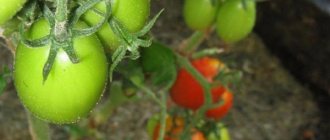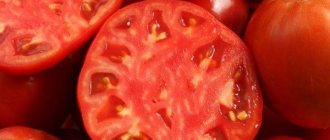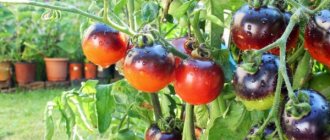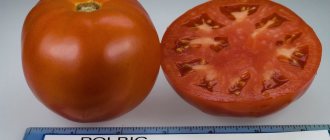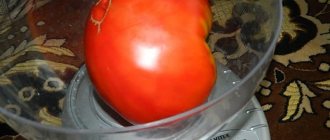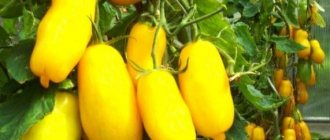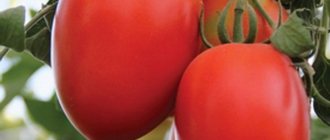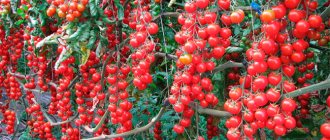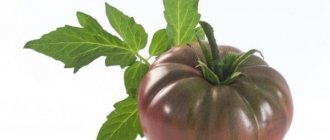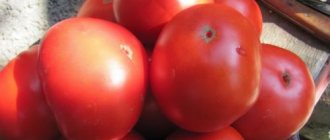The Marusya tomato has gained wide popularity, the characteristics and description of the variety indicate its unpretentiousness and excellent taste. Bred by Russian breeders in 2007, it is still loved by vegetable growers in all regions where it is cultivated.
In addition to its universal consumer properties, the Marusya tomato also attracts with its wonderful appearance. Lush green foliage beautifully frames clusters of small, bright red fruits that resemble large bunches of grapes.
Characteristics of the variety
Determinate tomato bushes Marusya grow small - no more than 1 m. The variety is mid-early, the period from the appearance of the first shoots to ripening is about 110 days. The bush forms one, sometimes two stems. The successful arrangement of juicy dark green leaves of the usual type helps protect the fruits of the Marusya tomato from sunburn, but does not interfere with their light exposure.
Due to its high resistance to adverse weather conditions and sudden temperature changes, the Marusya variety is widely distributed in many climatic zones - in open ground or in a film greenhouse. With proper care, tomatoes can produce up to 7 kg per square meter - up to 2 kg per bush, and with timely pinching, even more. The variety also demonstrates high resistance to diseases such as fusarium and verticillium. Descriptions and reviews of the Marusya tomato indicate only one small drawback - fruiting lasts only a month to a month and a half until the end of the summer season.
Brief information about the variety
- Fruits and bush : tomatoes are small, average weight is 80-100 g, oblong in shape, resembling a plum, red in color. The height of the bush is from 50 to 100 cm, the variety is determinate.
- Productivity : 2-2.5 kg per bush.
- Resistance : has average resistance to fungal diseases, tolerates frost, drought, and prolonged heat.
- Distribution : in the southern and central regions of Russia it grows well in open ground; in the northern regions it requires planting in greenhouses.
- Application : universal.
- Planting : through seedlings, planting in the ground is carried out in May, planting density - no more than 4 bushes per 1 m².
- Soil : light, enriched with potassium, nitrogen and phosphorus.
- Care : watering - once a week, fertilizing - according to schedule, moderate pinching, bush formation - 1-2 stems.
- Ripening period : tomatoes ripen from July to the end of August, the harvest yield is friendly. Long-term storage of fruits is possible.
Description of fruits
The dense, juicy fruits of the Marusya variety are oval in shape and acquire a bright red color at the stage of full ripening. The average weight of ripe tomatoes reaches 80 g. Due to their small size, they are convenient for canning. Despite the not very dense skin, Marusya tomatoes do not crack and tolerate long-term storage and long-term transportation. Already ripe fruits do not fall off, but remain firmly on the branches. Excellent taste makes them universal in purpose:
- tomatoes of the Marusya variety are consumed fresh and in salads;
- used in conservation;
- popular in the form of fresh juices;
- used in the preparation of sauces and vegetable stews.
Harvesting and application
Harvesting begins in July. Vegetables ripen together, in whole clusters, so they are easy to collect.
The use of tomatoes is universal. They are great for preparing fresh dishes, a variety of snacks, pizza, and sandwiches. Marusya is considered an excellent pickling variety. Small tomatoes are also used for whole-fruit canning and marinades.
Ripe tomatoes are processed for further preparation of ketchup, juices, adjika and pasta.
The species is distinguished by long-term storage without loss of presentation and can withstand transportation over any distance. Entrepreneurs are happy to breed the variety for sale, since there is an increased demand for tomatoes in the sales markets.
Seed preparation
Reviews advise sowing Marusya tomato seeds for seedlings about two months before transplanting into the ground. Therefore, it is important to correctly calculate the timing of their sowing, so as not to overexpose the seedlings in boxes. High-quality seeds purchased in specialized stores do not need to be disinfected. But those obtained at home or bought on the market are better to be disinfected. To disinfect Marusya tomato seeds, you can immerse them in a weak solution of potassium permanganate for 20 minutes. Some gardeners prefer to soak tomato seeds in aloe juice, a solution of baking soda or phytosporin for 10-20 hours. Undoubtedly, these substances have a stimulating effect on the seeds, due to which:
- their immunity is strengthened;
- germination improves;
- the productivity of tomatoes increases.
Important! The Marusya tomato is not a hybrid variety, so seeds for the next sowing can be prepared from the harvested crop.
Growing tomatoes
Tomato "Marusya" is grown through seedlings.
How to prepare seeds?
Preparation of seed material:
- Pre-sowing selection of seeds is carried out, rejecting all illiquid ones;
- Purchased seeds do not require a disinfection procedure. However, it is better to disinfect those collected independently or purchased on the market. To disinfect, seed material is soaked in a weak manganese solution for 20 minutes. Experienced gardeners use aloe juice, baking soda solution or Fitosporin (for 10-20 hours) for soaking. In addition to the stimulating effect, the immune system is strengthened, seed germination is improved, and future yields are increased.
Sowing seed material
Step-by-step instruction:
- Seed material is sown 50-55 days before planting in a permanent place;
- Special soil is prepared in advance. Take two parts of turf or garden soil and add one part of washed river sand. Also, the resulting soil mixture must be disinfected in any suitable way: by calcination in the oven, pouring with boiling water or a strong concentration of manganese solution. Afterwards, the disinfected soil is well moistened and left in a cool place for two weeks so that beneficial microflora multiply in it;
- Seed material is sown in containers filled with soil. They are sprinkled with a small layer of soil on top;
- The temperature in the room with seedlings should not be lower than +16 ºС;
- After the formation of two true leaves, the seedlings need to be picked into separate pots.
Pteris fern: description of species, home care
Rules for planting seedlings
Recommendations for proper planting:
- The seedlings are planted in a permanent location as soon as the weather is consistently warm and the soil is well warmed up;
- Immediately before planting, the soil is fertilized using minerals with a high content of phosphorus and potassium;
- Plant in unprotected soil in the evening or on a cloudy day to protect delicate seedlings from direct sunlight;
- The width between the rows is 70 cm, the interval between planting holes must be at least 60 cm;
- Tomato seedlings are planted to a depth of 5 to 7 cm.
Sowing seeds
The soil for sowing seeds of the Marusya variety should also be disinfected using one of the following methods:
- bake in the oven;
- pour with boiling water or a concentrated solution of potassium permanganate.
After disinfection, the soil must be moistened and placed in a cool place for two weeks to allow beneficial microflora to multiply in it. For sowing seeds:
- small boxes are filled with ready-made soil;
- Tomato seeds are laid out on its surface in rows at a distance of 2 cm, 3-4 cm can be left between the rows;
- the seeds are sprinkled with a thin layer of loose soil;
- for their germination it is necessary to create a warm and humid microclimate, so the beds are moistened and placed in a warm place with a constant temperature of approximately +25 degrees;
- to speed up growth, you can cover the boxes with transparent film or glass;
- after the first shoots of tomatoes appear, Marusya’s description recommends providing the beds with good lighting, so the boxes are placed on the windowsill;
- if the intensity of daylight is insufficient, fluorescent lamps can be used;
- The ambient temperature should be reduced slightly, otherwise the tomato sprouts will begin to stretch.
Features of cultivation and storage
The seedlings are transplanted into permanent beds at the age of 50-55 days.
The area is pre-fertilized using:
- 7-8 kg of compost;
- 10 g potassium sulfate;
- 30 g superphosphate.
Also add 1 cup of wood ash per 1 m2.
So that the tomatoes are not crowded and have enough light, they are placed according to the 40*70 cm pattern. This is 3-4 bushes per 1 m2.
What nuances are taken into account when growing:
- maintaining bushes with 3 trunks;
- moderate watering, norm 6-7 liters per 1 bush;
- application of fertilizers in the form of solutions during flowering and ripening.
Ripe tomatoes can be stored for up to 1 month. To do this, use cool, dark rooms.
Seedling care
The film should be removed from the seedlings gradually, opening it briefly over the tomato sprouts every day. They should be watered carefully as the top layer of soil dries. As the tomato seedlings grow, Marusya will require more frequent watering, but flooding the soil with water is also unacceptable.
Marusya tomato seedlings, as recommended by the description of the variety, photos and reviews, need to be hardened off. On warm spring days, take it out onto the balcony or outside, first for about five minutes, and then gradually increase the exposure time. Hardened seedlings adapt faster and grow after transplanting to a new location. 10-14 days after the emergence of seedlings, you need to make the first fertilizing of the Marusya variety with natural organic matter. In the future, it is advisable to carry them out every 7-10 days.
After two leaves appear, tomatoes of the Marusya variety need to be picked into separate cups. Many gardeners use peat pots, which are convenient to plant later in the soil. Picking seedlings requires special care, since the sprouts are still very tender and fragile.
After approximately 1.5 months, flower clusters begin to appear in tomatoes of the Marusya variety. They indicate the need to quickly replant tomatoes in a permanent place - in a greenhouse or open ground. Seedlings cannot be kept in pots, otherwise their growth will be retarded. It will not be able to grow into full-fledged tomatoes in the future. 10-14 days after the flower clusters appear, peat pots with seedlings of the Marusya variety need to be replanted. If there is a need to delay the timing of transplanting seedlings, gardeners resort to a little trick - they pinch off the flower cluster that appears. Since the next one will grow only in a week, you can delay replanting the plant for this time.
Marusya - excellent European tomatoes from the “cream” category
Marusya is a European tomato variety with a Russian name. It is in demand in many countries; both farmers and owners of personal plots love to grow it. Let us reveal the secret of the popularity of these tomatoes and the nuances of agricultural technology.
Description of the tomato variety Marusya and its characteristics
The author of the variety is the breeding company Satimex QUEDLINBURG (Germany). Its official representative in Russia (Agroplaneta LLC) acted as the originator and in 2006 submitted an application for state variety testing. In 2007, the variety was included in the State Register and received permission to be grown in all regions of the country. Marusya is grown in its homeland in Germany and other European countries, including Ukraine and Belarus.
Marusya tomatoes are recommended to be grown in open ground and film greenhouses. The variety is immune to Fusarium wilt and verticillium wilt. Heat resistant. Fruit ripening begins 105-110 days after full germination, occurs quickly and abundantly, but does not last long. Within 3-4 weeks, all tomatoes ripen and the crop can be eliminated. The yield of the variety is 6.9 kg/m2, which is a good indicator for medium-fruited tomatoes.
Appearance
The type of growth of the bush is determinant, that is, growth is limited by the formation of a flower cluster at the top of the stem (terminating). The height of the plant is 50-80 cm, in a greenhouse it can reach one meter. The leaves are medium to large in size, green. The inflorescence is simple, the stalk has an articulation. Fruit clusters begin to form after the sixth leaf with an interval of 1–2 leaves. The bush needs a garter.
The height of the Marusya tomato bush is 50–80 cm; in a greenhouse it can reach one meter
Description of fruits
The fruits are ovoid in shape - these are popularly called cream. Unripe fruits are light green, and fully ripe ones are red. Tomatoes are hard, dense, smooth. The skin is thin, but durable, not prone to cracking. The pulp is not juicy, but very tasty. The sizes of the fruits are equal, their average weight is in the range of 80-95 grams. The fruits have a universal purpose. They are delicious in salads - they do not drip, and are also ideal for whole-fruit canning, including without skins.
Tomatoes of the Marusya variety are hard, dense, smooth
Judging by the description, Marusya tomatoes are excellent for drying. This has been a hobby in our family for the last 3-4 years after we purchased an electric hot air dryer. Sun-dried tomatoes, cut into halves along the fruit, are placed in half-liter glass jars, sprinkled with spices and poured with olive oil. The result is delicious canned food (the kind produced in Italy), which previously we were only able to try occasionally, since they are quite expensive here (in eastern Ukraine). Now we have the opportunity not only to feast on delicious products, but also to give small gifts to friends.
Marusya tomatoes have good keeping quality and transportability, which, combined with other advantages, makes them commercially attractive.
Video: review of pickling tomatoes, including the Marusya variety (from the 4th to the 5th minute)
Advantages and disadvantages, features and differences from other varieties
Marusya tomatoes have a significant list of advantages and disadvantages:
- early ripeness;
- immunity to diseases;
- heat resistance;
- ease of care;
- possibility of propagation by own seeds;
- productivity;
- equalized fruit sizes;
- excellent taste fresh and canned;
- universal use;
- keeping quality;
- transportability;
- attractive presentation.
Transplanting seedlings and caring for them
The Marusya tomato, according to the description, can be transplanted into the soil if the night frosts have ended and the soil has warmed up to +16 degrees to the depth of the roots. High-quality seedlings must have:
- powerful root system;
- thick strong stem;
- dense fleshy foliage.
Plantings are carried out in the evening or on a cloudy day. Tomato bushes are planted at a distance of 0.6 m from each other, a little more is left between rows - 0.7 m. After the plants adapt, pinching is carried out, but only up to the first cluster. According to reviews, caring for the Marusya tomato variety is simple:
- regular watering with settled water;
- loosening the soil and removing weeds; mulching with straw or compost;
- preventive treatments against pests and diseases;
- gartering bushes after fruit appears.
Important! Tomatoes of the Marusya variety can crack if watering is carried out irregularly and the soil has time to dry out. Mulching will help retain moisture under the bushes.
Growing in open ground
Seedlings about 1.5 months old are planted in open space at the end of April or beginning of May. The exact time depends on the region and temperature conditions. Proper compliance with planting conditions and rules guarantees a good future harvest.
Outdoor growing conditions
The weather should stabilize, and the temperature at night should not fall below 15-16 C. Even short-term frosts can destroy young shoots.
The surface layer of soil up to 25 cm deep should warm up to 16-18 C.
Tomatoes should be planted when there is almost no sun. Better in the morning or evening. It is advisable that in the following days the sun should not shine brightly or not exist at all.
You can learn more about growing tomatoes in open ground from this article.
Soil and fertilizers
A tomato grows better if carrots, legumes, zucchini or cruciferous vegetables grew in the same place before it. The soil needs to be prepared in advance and fertilized in the fall.
In the spring, dig up the bed to a depth of 15 cm and add organic fertilizer in the form of vegetable compost or mature humus 1-2 weeks before planting. Mineral ones are also suitable for additional saturation of the soil. The applied fertilizers are mixed well with the soil. Afterwards, be sure to water everything.
Manure should not be used; it can burn through the fragile root system.
The day before planting, water to completely saturate the soil with moisture.
Selection of seedlings
It's worth making a selection. The young plant must be healthy. Have many juicy, rich green leaves on a thick and strong stem and a fully developed root. Seedlings should have the first flower cluster before the bud opens.
If the weather has not yet settled and a peduncle appears on the seedlings, you need to carefully pinch it off.
Landing
Tomato is planted in rows. The distance between them is 65-75 cm. The row consists of holes located 40-60 cm from each other. The depth of the hole is 15-20 cm and the width is 10-15 cm.
Step by step process:
- Place the seedlings together with a lump of earth into the prepared hole 1-2 cm deeper than its growth level in the container.
- Sprinkle with soil and water generously with warm, settled water.
- For each hole, prepare in advance a strong support, in the form of a wooden stake, to tie the plant down as it grows. Place it at a distance of 7-9 cm from the future bush.
When planting a plant in a hole, you can shorten the main root slightly. There will be stimulation for the growth of lateral roots. In the future, the tomato trunk will be stronger.
Pest Control
Despite its high resistance to the most common diseases, the Marusya tomato requires preventive spraying, as well as treatments against pests:
- Phytosporin with whey and a few drops of iodine or wood ash protects against late blight;
- Infusions of wood ash, tobacco dust or lime solution are effective against slugs;
- Periodic spraying with a soap solution is also useful;
- Karbofos is used against spider mites.
Advantages and disadvantages
The positive characteristics of tomato include:
- ease of care;
- ability to set fruit in unfavorable conditions;
- adaptation to any climate;
- high yield;
- resistance to certain diseases;
- excellent taste of fruits;
- universal purpose;
- possibility of breeding for sale;
- high demand for ripe vegetables;
- long-term storage;
- long transportations.
Disadvantages of the species are the need for a garter and moderate pinching. But these procedures are quite simple and do not take much time.
Reviews
Melnikov Stepan, 72 years old, Kaluga
I have been planting the Marusya tomato for several years now. It is easy to care for - I regularly water and weed the beds. I collect my own seeds from overripe tomatoes, dry them and put them in paper bags, and share them with my neighbors in the spring. Following my example, they also switched to Marusya tomato. The variety is excellent.
Kartashova Galina, 60 years old, Samara
For the first time, having tasted the extraordinary taste of tomatoes, Marusya decided to plant them in her dacha. And I still don’t regret it. Even in dry years, tomato produces good yields. I use only this variety for pickling and recommend it to everyone I know.
Kramarenko Vitaly, 45 years old, Nizhny Novgorod
For two years now I have been growing only the Marusya tomato on my plantations. Due to its delicious taste and excellent presentation, the tomato is in great demand. The fruits do not fall off, so harvest losses are small. Our scientists have developed an excellent variety.
Elizaveta Slonova, 57 years old, Astrakhan
We know and love the Marusya tomato, the photo and description are true. The variety is very popular among our summer residents. Sweet fruits add an extraordinary taste to salads and vegetable dishes. We also use this variety for pickling. Bushes also play a decorative role - they decorate the garden with bright bunches of tomatoes.
Reviews about the variety from those who planted
The presence of excellent marketable fruit allows the Marusya tomato to be grown on an industrial scale, which is appreciated by farmers.
No less important is the versatility of using red tomatoes. For home gardens, “Marusya” is one of the best determinate tomato varieties. It is a pleasure to care for it, and the yields are consistently high. The pleasant taste characteristics of tomato fruits allow them not only to be consumed fresh, but also used for canning. Thanks to many positive qualities, the tomato variety “Marusya” enjoys well-deserved love among Russian gardeners and farmers. It is guaranteed to produce good yields even when grown in unfavorable weather conditions. With its attractive appearance, “Marusya” will decorate both a personal plot and a greenhouse structure.
What kind of fish is sole: its benefits and harms
Diseases and pests
The tomato variety “Marusya” has excellent immunity to characteristic tomato diseases, in particular to late blight. However, it is worth remembering about prevention:
- If cracks are found on both unripe and ripe tomatoes, it is necessary to adjust the watering regime, and the problem will disappear;
- The drug “Confidor” is effective against whiteflies;
- You can get rid of slugs by sprinkling the soil next to the tomato bushes with ash, lime and tobacco dust;
- You can fight spider mites by spraying the plantings with Karbofos.
